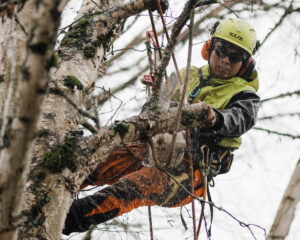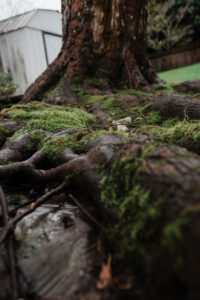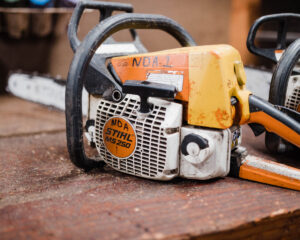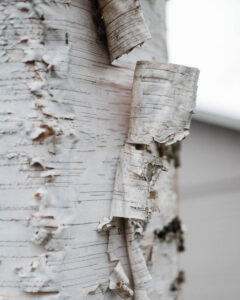 September is the Time to Look for Hazards Before Storms
September is the Time to Look for Hazards Before Storms
In September summer is waning, fall is coming, and winter is just around the corner. September is an excellent time to try and get ahead of the pack and look for potential tree hazards that can be mitigated.
The Problems to Check For
The fall brings rain and higher winds. And while plant material heaves a sigh of relief for the rain, that also means increased stress on limbs.
The fall can bring small wind events. These small events coupled with a tree’s full leaf canopy and a little extra water weight from a recent rainstorm can sometimes be too much for certain trees. Overextended limbs can break due to excessive weight.
Additionally, poorly attached co-dominant stems can completely fail due to poor attachment points and too much stress.
September Tree Solutions
Luckily we are able to prune back overextended limbs, remove limbs that are problems, and perform structural pruning to improve the long-term architecture of the tree. Our pruners look for good cutback points to prune so that the health of the tree is maintained. At the same time as pruning, we can run through the canopy and look for any hazards (deadwood) that might exist. Our goal is to get ahead of potential failures. By reducing certain limbs and reducing the size of limbs/leaders with poor attachment points, our goal is to decrease the chance of failure in the future.
Our Arborists look for the most reasonable work plan for your trees. We approach each client’s trees as if they are our own. We prioritize tree care as though these are our trees and our money. Our goal is to present you with the problems we see, in order of importance, and tell you whether something is worth spending money on. A large part of Tree Management is creating short-term and long-term goals. We approach each property with this in mind.
Our Approach to Pruning Trees
When we prune trees, we make wounds on the tree where we cut them. This means we had better have a good reason for making that cut. Remember: The one positive is the goal we are accomplishing (Building Clearance, Structural Pruning, End Weight Reduction). Those types of pruning cuts must overshadow the three negatives each cut makes. The three negatives in each cut are:
- The wound must be compartmentalized. Trees cannot “heal” wounds. They can only build CODIT walls (Compartmentalization Of Decay In Trees) around the wound. These walls take energy to produce. That energy must come out of the carbohydrates (energy) reserves that the tree has planned for something else. It is like taking money out of your savings account for a project you did not have planned.
- There were carbohydrates (energy) the tree already created and stored in the limb that we are taking off. This is like taking money out of your savings and just throwing it away.
- The leaves were energy producers. By making a pruning cut, we remove the limb and leaves on that limb. Those leaves were going through photosynthesis and had earning power for the future. (next week’s paycheck is 10% smaller).
Our pruning goals are to balance the tree’s needs while ensuring the safety and health of your friends, family, and property.
 October is the Time to Consider Planting Trees
October is the Time to Consider Planting Trees
As we shift gears from summer to fall each year, we also have to switch our thoughts to planting new trees this winter. You might ask, “Why do we need to think about this at an exact time?” Here is why.
Why Seasonality Matters To Trees
- Trees take a long time to grow in the field.
- We need to get orders sent to growers for the variety you want ASAP; otherwise, the tree you want might not be available.
- We try to schedule planting jobs in the winter as best as we can so that they can go from field to trailer to your yard as quickly as possible.
- The more patience you have in getting a new tree, the exact species/variety/ size will be more likely to be available.
- It is better for the tree to be planted in the winter/early spring.
- There are hundreds of species and varieties to choose from, each with a different purpose.
The Timeline for Planting New Trees
When we discuss replacement trees with clients, we are mostly talking about larger “B&B” trees. What is “B&B”? That is short for balled and burlaped. Trees grown for re-sale are dug either by hand or by a large mechanical tree spade. These trees are then placed in wire baskets with burlap tied around the root ball. This process is done on a large scale by growers.
One grower we buy from in Central Oregon has between 4,000 and 5,000 acres of trees and shrubs. This means they follow a rigorous timeline to get everything done on time and when it is best for the plant. We hire a local grower who has a tree spade to dig trees that we grow on our property. We have our trees dug in Dec/Jan when our digger has time.
When they dig the tree and tie it in the wire basket, the tree’s root system is suddenly damaged from digging and exposed to the elements. To help minimize the shock to the tree, they dig when the trees are dormant. This means they are digging their upcoming inventory between October and December. Our goal is to get the trees in Nov-Jan, and get them in the ground as quickly as possible.
Trees Take Time to Grow
Trees as a product take 3-5 years to produce. This means growers are trying to forecast plant stock for 3-5 years in the future. Most of their stock is sold before it is dug. Often times we will call to place an order, and have to change our selection based on what is available. The farther out we can place an order the better chance there will be of the tree being available. We send 10-12 trucks/trailers down per year to get trees for the upcoming season.
We try to plant trees so that they will thrive in your yard. This means planting them while they are dormant, in the winter or early spring. This also means we want to minimize exposure to extreme temperature changes before planting. We try to schedule planting jobs in the winter as best as we can so that they can go from field to trailer to your yard as quickly as possible.
Container grown plants
You might be saying, “What about all the trees I see at the local nursery? Aren’t all those out in the elements all year long?”
The answer is: In the post above, we are talking about larger 2-3″ diameter (28″-32″ root ball) trees. Smaller B&B trees and plant material in pots have less transplant shock because they are smaller. Nursery stock also gets turned over as inventory much more quickly than large plant material.
They are smaller and produced, shipped, sold, and planted more quickly, so there are fewer concerns with plant material loss. Logistics is on the side of smaller plant material. Additionally, smaller plant material is often grown in containers and simply moved to larger pots each year. It is impossible to do this with large trees, and logistics make the management of large trees more difficult.
If you have any questions regarding new trees for your yard, please do not hesitate to ask. There are hundreds of varieties of various species of trees, all with different purposes. We want to help you fit the correct tree to your space and desired outcome.
Please let us know if you have any general tree pruning and removal questions by calling us at (360)-887-6955.
November is Time to Deadwood Conifers
At New Day Arborist, one of our goals is to mitigate hazards before they become an issue. One of the most simple and straightforward problems is deadwood in trees.
 Naturally, all trees will end up with deadwood in the canopy. The overwhelming majority of the time, this does not mean that your tree is dying. Often time it is due to competition from neighbor limbs. If another constantly shades one limb, it will be aborted over time, and the limb will die. If this is a small tree, then the solution hazard is small and the solution easy. However, if this is a large tree, then the hazard and need for a solution both increase.
Naturally, all trees will end up with deadwood in the canopy. The overwhelming majority of the time, this does not mean that your tree is dying. Often time it is due to competition from neighbor limbs. If another constantly shades one limb, it will be aborted over time, and the limb will die. If this is a small tree, then the solution hazard is small and the solution easy. However, if this is a large tree, then the hazard and need for a solution both increase.
Deadwood is Unsightly and Hazardous
Deadwood throughout the canopy of a tree is relatively normal. In the forest, this is the natural state of things. However, your house is not in the middle of the forest. The less important consideration is simply that deadwood throughout the canopy of your conifers makes the crown look messy. More importantly, this can be a hazard. Deadwood can fall out of the tree during small wind gusts. It is possible with most trees that the dead limbs can hold on for a number of years. However, as time goes on, the chance that dead limbs will fail increases. We consider dead wood over 2” to be of concern. That is the size that our pruners are looking for when they are working.
Why Deadwood Conifers?
The simple answer is: “It is easy to see deadwood in conifers any time.” Depending on the tree, it can be easier or harder to see deadwood in the tree. It is very hard for us to see deadwood in trees like Maples, Oaks, or Ash from December through March because they are deciduous. They have lost their leaves for the winter, and even the most attention to detail arborists can miss some. We prefer to deadwood those in the summer (look for my email in May). However, Conifers hold their needles year-round. That means we can be more efficient when we are working in the winter and provide you more bang for your buck.
If you have any questions or would like to have us take a look at your trees, please do not hesitate to contact myself (Garrett) or Jeff. We will come out and provide you with an estimate to make your yard safe if you call us at (360)-887-6955.
December is Time to Sign-up for Insecticide Application
What plant material is affected by what insects?
December is time to consider insecticide applications for trees and shrubs that are susceptible to insect damage. Birch trees in our area have been getting hit hard by the Bronze Birch Borer. Additionally, Azaleas and Rhododendrons have been getting attacked by Lace bug. There are other pests out there. We are going to discuss the ones we see most often.
What to look for:
You can sometimes see a stain on the bark on Birch trees, almost like a coffee stain, and a “D” shaped hole. Look for deadwood throughout the canopy. If you are unsure, call us, and we can come to take a look.
With Birch trees, we try our best to be honest with our clients on whether it is worth keeping the tree and treating it vs. removal of the tree and replacing it with a better species. We want to be as honest as possible and will try our best to guide you in the right direction for your property plans.
Rhodies and Azaleas have been affected with Lace bug. This insect has a sucking mouth part and will remove chlorophyll from the leaves. You should look for leaves with excessive white spots and a lack of color. Additionally, look at the back of the leaf, and you will often times have black spots on the underside of the leaf. These are signs that these plants are affected by Lace bug.
 What can we do to stop Insect Infestations on Trees and Plants?
What can we do to stop Insect Infestations on Trees and Plants?
Changing the conditions the plant lives in is the best long-term strategy. This mainly has to do with reduced stress on the plant material. Just like you and me, if the tree gets too stressed, it becomes susceptible to disease. Increasing water on Birch is the best thing in the summer. Consider long, infrequent soakings of the root system.
Arborist chips are the best soil medium to use for plant material. The brush fed through our chipper becomes the most nutritious mulch for you soil. There are a lot of different types of fungus that break down the chips our crews make. The chips and fungus drastically improve soil structure and help hold moisture throughout the summer. Wood chips can decrease the amount of watering you need to do to be effective.
How We Apply Chemicals like Insecticides
We do not aerosolize the chemical to apply it. To try to keep the application to the specific plant as centralized as possible, we use a combination of things. The first is to inject the soil with the chemical directly. This puts nearly all of the chemicals into the ground, right near the root system. There is very little “overspray” with this method. We want to make sure we are not harming other insects or bees.
The second method is to use another chemical and spray it directly onto the trunk of the tree/shrub. This second chemical helps the insecticide absorb into the plant’s bark. We spray directly on the stem.
Keeping Birch vs. Removing & Replacing
Sometimes a tree needs to be removed. We always think about your property as if it is our property. We make recommendations based on this concept. We will let you know if the tree is worth saving and provide an action plan. However, sometimes the cost of treatment yearly does not make sense depending on how large the tree is and how long you plan on living in the house. We can help you make the decision to keep the tree, or replace it with a better species.
When We Apply Chemical Plant Treatments
We start insecticide applications in February, and perform them through April. Please email Garrett@newdayarborist.com or Office@newdayarborist.com to have us place you on our list.
How Much does Pesticide Application Cost?
Minimum Service Charge $125 (WA) $165 (OR)
Trees: Billed at $5.50/ diameter inch
Examples:
1 tree at 10″ X $5.5 = $55.00 + $70MinServChrg = $125
OR
6 Trees each at 10″ = 60″ x $5.5 = $330.00
Shrubs billed by time and product quantity.
March is the Time to Focus on Fruit Trees
March is a special time of year, the days are getting longer, and we finally get to see the sun again. Imagining all that will emerge in the coming months is special too.
Where & How to Work in March
We start to think about the vegetable garden. You can plant potatoes, onion starts, and sugar snap peas. Most fruit tree pruning is done between January and May.
It’s important to keep the trees’ structural limbs low, which will mean the scaffolding and smaller limbs will be low enough to reach the fruit. We try to keep all fruit trees under 7′.
It’s essential to prune fruit trees for many reasons, but the two primary reasons are the effects of the weight of the fruit (gravity) and the location of the fruit (height).
If you have a fruit tree that has become oversized, sometimes it’s better to think of it as an ornamental tree. It becomes too difficult to bring the height down to a low enough elevation to pick – it can be done, but it’s very time-consuming.
Don’t be Afraid to Cut Down Old Fruit Trees
I would also encourage you to go to the Nursery to check out the new varieties of fruit trees they stock. If you don’t like the tree you have because of the taste, texture or location don’t hesitate to change it out to a variety you will enjoy.
Other Plants to Prune in March
The other plants that need pruning in either late February or March are the roses. There are many varieties, and there are differences in how you prune them. Wait until late May or June before thinking about pruning the conifers and hedges, usually after their new spring growth.
Most companies start to get booked up beginning in March. If you need our assistance with tree and plant care, please reach out sooner rather than later.